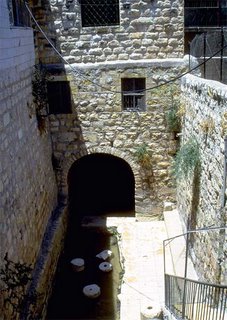
As he Jesus went along, he saw a man blind from birth. 2 His disciples asked him, "Rabbi, who sinned, this man or his parents, that he was born blind?" 3 "Neither this man nor his parents sinned," said Jesus, "but this happened so that the work of God might be displayed in his life. 4 As long as it is day, we must do the work of him who sent me. Night is coming, when no-one can work. 5 While I am in the world, I am the light of the world." 6 Having said this, he spat on the ground, made some mud with the saliva, and put it on the man's eyes. 7 "Go," he told him, "wash in the Pool of Siloam" (this word means Sent). So the man went and washed, and came home seeing. 8 His neighbours and those who had formerly seen him begging asked, "Isn't this the same man who used to sit and beg?" 9 Some claimed that he was. Others said, "No, he only looks like him." But he himself insisted, "I am the man." 10 "How then were your eyes opened?" they demanded. 11 He replied, "The man they call Jesus made some mud and put it on my eyes. He told me to go to Siloam and wash. So I went and washed, and then I could see." (NIV John 9:1-7)
The picture (courtesy of Dr. Peter Gentry) of the pool to the right was believed by Christians from the Byzantine period to be the Pool of Siloam. However, recently it is believed that the real Pool of Siloam has been discovery just southeast of here calling this pool into question. It was discovered recently by Israeli archaeologists under the supervision of Eli Shukron of the Israel Antiquities Authority. City workers in Jerusalem were working on damaged sewer lines when they discovered an even older water system.
The large miqveh (Jewish ritual cleaning bath) was some 225 ft long and used by Jews going up to Jerusalem by immersing themselves in the Pool of Siloam. The water was supplied by Hezekiah’s Tunnel built in the 1st century B.C. and destroyed in A.D. 70 by Emperor Titus during the destruction of Jerusalem.
Several coins were discovered in the silt which filled the pool helping Archaeologists date the silt to around A. D. 66 to 70. Further work needs to be done to uncover the remainder of the pool. Part of the pool runs through the garden of the Greek Orthodox Church and archaeologists will need to gain their permission to dig any further.
For pictures and the complete article in Biblical Archaeology Review Magazine click here.

No comments:
Post a Comment